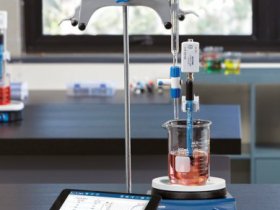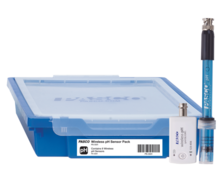

















Here’s the best tool for measuring pH since litmus paper. The Wireless pH Sensor connects via Bluetooth® to monitor the pH of solutions.
- 1x Coin cell battery
- 1x Direct-connect BNC pH probe
- 1x Probe storage bottle and solution
See the Buying Guide for this item's required, recommended, and additional accessories.
Product Summary
The Wireless pH Sensor is a must-have for any chemistry, biology, or environmental science course. Equally capable in the lab or field, the sensor eliminates the hassle of cables, reducing spills and improving safety. Plus, it rarely requires charging; the sensor's coin cell battery lasts for 2-3 years in most labs and costs about one dollar to replace. It can transmit data in real time, or store data for days when continuous monitoring is required. The Wireless pH Sensor enhances countless activities, including acid-base titrations, investigations into household chemicals, analyses of chemical reactions, water quality studies, and much more.
The Wireless pH Sensor uses a BNC connector to attach the pH probe. This amplifier can be used with other probes as well, such as the ORP, Flat pH, and ISE electrodes. Please see the buying guide for a full list of compatible accessories.
Features
- Simply pair and go, no cables or interfaces to manage
- Compatible with ion-selective electrodes (ISE) and the oxidation reduction probe (ORP)
- Bluetooth® connectivity and a long-lasting coin cell battery
- Logs pH data directly onto the sensor for long-term experiments
- Wirelessly connects to SPARKvue and Capstone for intuitive analysis and lab reports
Perform These Experiments
- Monitor pH during chemical reactions
- Investigate household chemicals
- Explore acid-base titrations
- Investigate the chemistry of buffers
- Measure pH for water quality studies
What's Included
- 1x Coin cell battery
- 1x Direct-connect BNC pH probe
- 1x Probe storage bottle and solution
Product Specifications
| pH Range | 0 to 14 pH |
| Resolution | 0.02 pH |
| Accuracy | ±0.1 pH with calibration |
| Temperature Range | 5°C to 60°C |
| Connectivity | Bluetooth 5.2 |
| Logging | Yes |
| Battery | Coin Cell |
Battery & Logging
| Stored Data Points Memory (Logging) 1 | >55,000 |
| Battery - Connected (Data Collection Mode) 2 | >220 hr (2-3yrs of normal classroom use)* |
| Battery - Logging (Data Logging Mode) 3 | 90 days |
| Battery Type | Coin Cell |
1 Minimum # of data points with all measurements enabled, actual results depend on enabled measurements.
2 Continuous use in a connected state until battery failure, actual results will depend on sample rate, active measurements, and battery condition.
3 Logging until battery failure, actual results will depend on sample rate, active measurements, and battery condition.
* Normal classroom use is the sensor in active use for 20min/lab for 120 lab periods/yr.
Data Collection Software
This product requires PASCO software for data collection and analysis. We recommend the following option(s). For more information on which is right for your classroom, see our Software Comparison: SPARKvue vs. Capstone »
Connectivity Options
This product can connect directly to your computer or device with the following technologies. No Interface required. See the following guide for details regarding device compatibility: Wireless Bluetooth Product Compatibility »
Dedicated Datalogging with SPARK LXi2
Consider an all-in-one, touchscreen data collection, graphing, and analysis tool for students. Designed for use with wired and wireless sensors, the SPARK LXi2 Datalogger simultaneously accommodates up to five wireless sensors and includes two ports for blue PASPORT sensors. It features an interactive, icon-based user interface within a shock-absorbing case and arrives packaged with SPARKvue, MatchGraph!, and Spectrometry software for interactive data collection and analysis. It can additionally connect via Bluetooth to the following interfaces: AirLink, SPARKlink Air, and 550 Universal Interface.
Buying Guide
| Recommended Accessories | P/N | Price |
|---|---|---|
| Storage for Wireless Temperature, pH and Conductivity Sensors | PS-3585 | -- |
| pH Buffer Capsule Kit | SC-2321 | -- |
| Electrode Support | PS-3505 | -- |
| Magnetic Stirrer | SE-7700 | -- |
| PASCO Micro Stir Bar (5 Pack) | PS-2565 | -- |
| Parts Available Separately | P/N | Price |
|---|---|---|
| Oxidation Reduction Potential Probe | PS-3515 | -- |
| Flat pH Probe | PS-3514 | -- |
| Chloride Ion Selective Electrode | PS-3519 | -- |
| Carbon Dioxide Ion Selective Electrode | PS-3517 | -- |
| Potassium Ion Selective Electrode | PS-3520 | -- |
| Calcium Ion Selective Electrode | PS-3518 | -- |
| Ammonium Ion Selective Electrode | PS-3516 | -- |
| Nitrate Ion Selective Electrode | PS-3521 | -- |
| Replacement Parts | P/N | Price |
|---|---|---|
| Soaker Bottle Replacement pH/ISE (5 Pack) | SE-3408 | -- |
| pH Electrode | PS-2573 | -- |
| pH Storage Solution | SC-3507 | -- |
| Coin Cell Battery Pack | PS-3504 | -- |
| Also Available | P/N | Price |
|---|---|---|
| Wireless Drop Counter | PS-3214 | -- |
| Heater Stirrer | PS-3401 | -- |
| USB Bluetooth Adapter Required by older computers without bluetooth 4.0 or later | PS-3500 | -- |
Product Guides & Articles
AP Chemistry Lab Manual Overview
Authored by chemistry educators, the Advanced Chemistry Through Inquiry Teacher Lab Manual includes sixteen guided inquiry labs that cover AP Chemistry course concepts such as Moles and Molar Mass, Stoichiometry, and Reaction Rates.
pH Sensors & Probes
A pH sensor is a type of probe used to measure the pH of solutions in chemistry, biology, and other science applications. pH probes are often used to determine the basicity or acidity of an aqueous solution.
Acid-Base Chemistry
Acid-base chemistry is present everywhere in our daily lives. Many substances are acidic and basic, while others are neutral. The determining factor that makes a substance an acid or a base is the amount of hydrogen ions or hydroxide ions present.
Titration
A titration is a chemical analysis in which a researcher determines the concentration of a chemical solution (analyte or titrand) by adding a measured volume of standard solution (titrant) until the produced reaction reaches the equivalence point.
Experiment Library
Perform the following experiments and more with the Wireless pH Sensor.
Visit PASCO's Experiment Library to view more activities.
Buffers in Biological Systems
Students use a pH sensor to explore the effect buffers have on the ability of a cell to maintain homeostasis
Physical or Chemical Change
Students use a pH Sensor, a Conductivity Sensor, and a Temperature Sensor to collect evidence that supports their conclusion about whether a chemical or physical change has occurred.
Determining Soil Quality
In this lab, students use carbon dioxide, conductivity, and pH sensors to determine the quality of different soil samples.
Sunlight and Photosynthesis in Aquatic Plants
In this lab, students will use pH sensors to demonstrate the relationship between photosynthesis and light.
Diprotic Titration: Multi-Step Chemical Reactions
In this lab, students will use a drop counter and pH sensor to determine the concentration of a sodium carbonate solution. Students will learn that chemical reactions can be the sum of several individual reactions.
Le Chatelier's Principle
In this lab, students will use a pH sensor to determine how concentration changes effect the equilibrium of a system. Students will relate pH values with the acid-base indicator phenolphthalein.
Ocean Acidification
Students use a pH sensor to explore the effect of excess atmospheric carbon dioxide on water pH.
pH of Household Chemicals
Students will use a pH sensor to determine the pH of common household substances.
Antacids: An Inquiry Study
Students use a pH sensor to investigate how antacid tablets work and use a back titration method to determine how much of the active ingredient is found in one tablet.
Organisms and pH
Students use a pH sensor to determine how effective various substances are at resisting large changes in pH.
Introduction To Buffers
In this lab, students use a pH sensor to create and analyze a buffer system.
Seasonal Pond Exploration
In this lab, students will use pH sensor and temperature sensors to measure temperature and pH over the course of a day in a vernal pond.
Support Documents
| Manuals | ||
|---|---|---|
| Wireless pH Sensor Reference Guide | English - 458.34 KB | |
| Safety Sheets | ||
| Lithium Battery Safety Data Sheet | English - 129.01 KB | |
| Wireless pH sensor KCl solution | English - 404.70 KB | |
| Knowledge Base | ||
| How do I troubleshoot connecting a wireless sensor? | Aug 22nd, 2022 | |
| Windows asks for a PIN number when connecting wireless sensor or device | Sep 18th, 2023 | |
| Android asks for a PIN number to pair a wireless device to system | Aug 29th, 2023 | |
| Emergency calibration standards for pH sensors | Apr 14th, 2022 | |
| How to install the Data Streamer app extension within Microsoft Excel | Apr 5th, 2023 | |
| Managing cap for soaker bottles | Mar 1st, 2024 | |
| pH Electrode Maintenance | Nov 13th, 2023 | |
| Proper preparation of coin cells for recycling | Dec 12th, 2022 | |

























